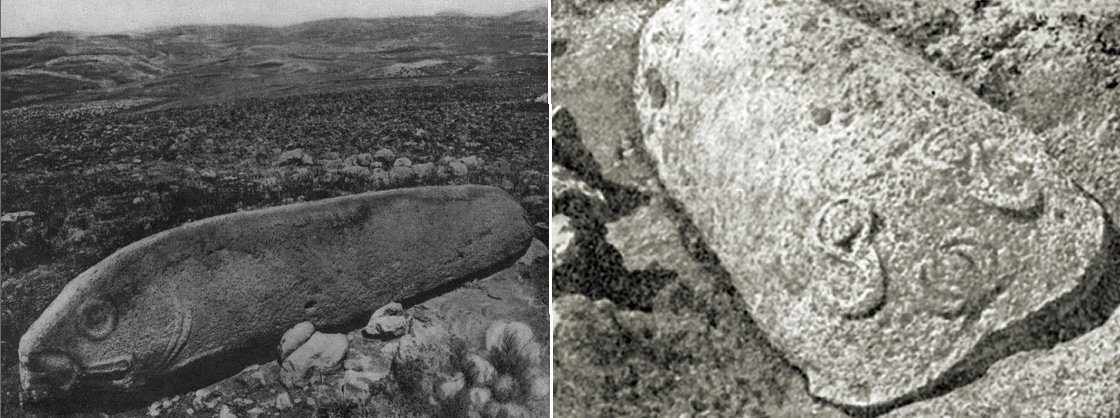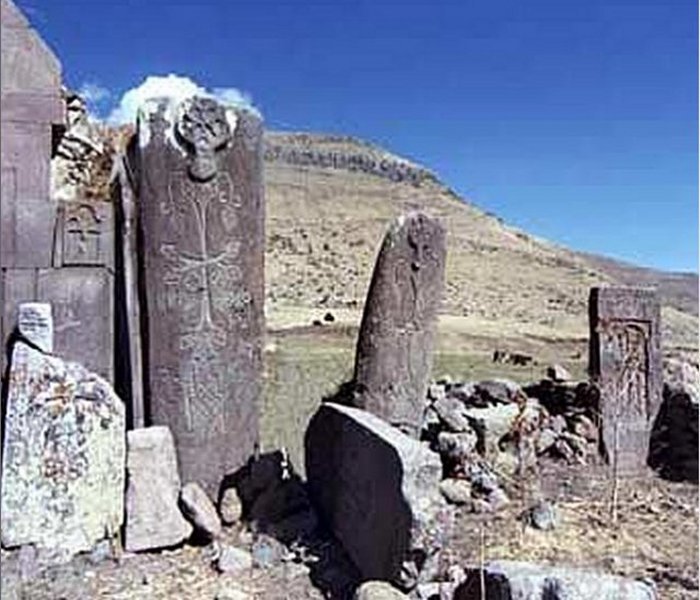Mysterious 2000-Year-Old Carved Vishap Stone Monuments Of Armenia
A. Sutherland - AncientPages.com - Vishap stones represent one of the more interesting mysteries of Armenian archaeology.
Vishaps are menhirs (large carved stones) that date back to 2000 BC. These formations, which had once religious significance, are believed to be related to water.
Vishap means for the Armenians - 'dragon' and such stone has a dragon or serpent-shaped 'head' carved at the top.
Usually, the Armenian vishaps have cylindrical or cigar-shaped forms and are grey in color. Their true ancient name is vishapakahr, derived from the Armenian word “vishap” meaning “serpent/dragon,” and “kahr” meaning “stone.” They can be from 10 to 20 feet tall.
In Armenia's pre-historic period, there was the worship of “Vishaps” (dragons), associated with the marine origins of life. Their likenesses in the form of large stone-fish figures were placed near water springs and canals.
The ancient Armenians believed that their land - "Land of the Armenians" - was protected by
Vahagn, who was worshiped as the God of War, Thunder, and Lightning. He fought the Vishaps,
killing them with his powerful lightning strikes.
Sometimes, the most ancient vishaps are so weathered or altered by weather and time that inscriptions on them are difficult to decipher.
One of the vishaps can be found at Garni, an ancient village, which was once a settlement inhabited almost continuously since 3000 BC. This vishap-formation is covered with a cuneiform inscription dated to the 6th century. Later, crosses were added to some of the vishaps to make them more like Christian monuments.
Tracing distant past of the vishaps, scholars determined that they could have been the forerunners of stelae - tetragonal (with four sides) columns standing on a cube-shaped base and functioning as gravestones or memorial stones.
They often had carvings depicting religious subjects in form of saints, biblical scenes or angels.
People do not know where they originate from and how they ended up in Armenia. According to Armenian mythology vishaps are dragons, which live in the mountains, especially on Mount Ararat.
They have been found on the north-eastern shore of Lake Sevan (the largest body of water in Armenia and the Caucasus region) and are often in association with water engineering and construction of big and small artificial lakes and a complex system of canals joining them.
Today, almost all Vishap (Dragon) stones are devastated; they were intentionally knocked down.
The exact dating of these megaliths presents certain difficulties. In the vicinity of these enigmatic ancient figures, there are no remnants of ancient settlements, fires, or other fossils, to which the radiocarbon analysis could be applied.
Written by – A. Sutherland AncientPages.com Staff Writer
Copyright © AncientPages.com All rights reserved. This material may not be published, broadcast, rewritten or redistributed in whole or part without the express written permission of AncientPages.com
Expand for referencesReferences:
D. Holding, Armenia
More From Ancient Pages
-
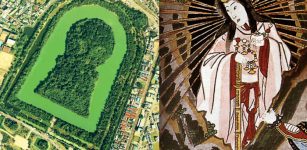 Mysterious Kofun – Ancient Japanese Tombs Were Aligned Towards The Rising Sun And Goddess Amaterasu – Satellite Images Reveal
Archaeology | Jan 20, 2022
Mysterious Kofun – Ancient Japanese Tombs Were Aligned Towards The Rising Sun And Goddess Amaterasu – Satellite Images Reveal
Archaeology | Jan 20, 2022 -
 Medici Family – Powerful Renaissance Godfathers And Patrons Of Galileo Galilei
Featured Stories | Dec 17, 2018
Medici Family – Powerful Renaissance Godfathers And Patrons Of Galileo Galilei
Featured Stories | Dec 17, 2018 -
 On This Day In History: Great Sheffield Flood – Largest Man-Made Disaster Occurred In England – On Mar 11, 1864
News | Mar 11, 2017
On This Day In History: Great Sheffield Flood – Largest Man-Made Disaster Occurred In England – On Mar 11, 1864
News | Mar 11, 2017 -
 Bartolomeo Colleoni: Most Respected Mercenary General Of The 15th Century Italy
Featured Stories | Sep 10, 2019
Bartolomeo Colleoni: Most Respected Mercenary General Of The 15th Century Italy
Featured Stories | Sep 10, 2019 -
 Echidna – Mother Of All Monsters – A Cave-Dwelling Female Hybrid Creature In Greek Mythology
Featured Stories | Jan 13, 2022
Echidna – Mother Of All Monsters – A Cave-Dwelling Female Hybrid Creature In Greek Mythology
Featured Stories | Jan 13, 2022 -
 Ancient Maps Reveal What Will Happen With Our Climate In The Future – Scientists Say
Archaeology | Oct 12, 2022
Ancient Maps Reveal What Will Happen With Our Climate In The Future – Scientists Say
Archaeology | Oct 12, 2022 -
 La Garma Cave Offers Evidence Of Over 300,000 Years Of Human Activity
Featured Stories | Dec 5, 2023
La Garma Cave Offers Evidence Of Over 300,000 Years Of Human Activity
Featured Stories | Dec 5, 2023 -
 Stunning Discovery Of 1,000-Year-Old Knight’s Sword From Reign Of Poland’s First King Bolesław The Brave
Archaeology | Jul 28, 2022
Stunning Discovery Of 1,000-Year-Old Knight’s Sword From Reign Of Poland’s First King Bolesław The Brave
Archaeology | Jul 28, 2022 -
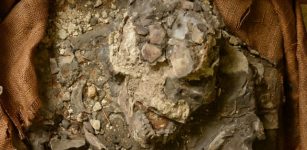 Extraordinary 6,500-Year-Old “Noah” Skeleton Re-Discovered – A Survivor Of The Great Flood Hidden In Museum
Civilizations | Aug 6, 2014
Extraordinary 6,500-Year-Old “Noah” Skeleton Re-Discovered – A Survivor Of The Great Flood Hidden In Museum
Civilizations | Aug 6, 2014 -
 Unique 2,500-Year-Old Celtic Jewelry – Oldest Iron Age Gold Treasure Ever Found In Britain
Archaeology | Mar 3, 2017
Unique 2,500-Year-Old Celtic Jewelry – Oldest Iron Age Gold Treasure Ever Found In Britain
Archaeology | Mar 3, 2017 -
 Birch Bark Tar Production Techniques Offer Evidence Neanderthals Had Cognitive Skills Similar To Modern Thinking
Archaeology | Sep 26, 2023
Birch Bark Tar Production Techniques Offer Evidence Neanderthals Had Cognitive Skills Similar To Modern Thinking
Archaeology | Sep 26, 2023 -
 10 Aztec Symbols Explained
Ancient Symbols | Mar 20, 2018
10 Aztec Symbols Explained
Ancient Symbols | Mar 20, 2018 -
 Vimanas Of The Rama Empire: Flying Machines Dominated Ancient Skies In Distant Past
Ancient Technology | Jul 23, 2017
Vimanas Of The Rama Empire: Flying Machines Dominated Ancient Skies In Distant Past
Ancient Technology | Jul 23, 2017 -
 On This Day In History: Mary Queen Of Scots Was Forced To Abdicate – On July 24, 1567
News | Jul 24, 2016
On This Day In History: Mary Queen Of Scots Was Forced To Abdicate – On July 24, 1567
News | Jul 24, 2016 -
 Brahma: First God In Hindu Trimurti, Creator Of The World And All Creatures
Featured Stories | Apr 17, 2019
Brahma: First God In Hindu Trimurti, Creator Of The World And All Creatures
Featured Stories | Apr 17, 2019 -
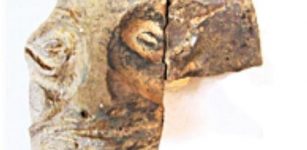 Satyr Mask Discovered In Ancient Greek Emporium Pistiros In Thracians’ Odrysian Kingdom Near Bulgaria’s Vetren
Civilizations | Sep 22, 2015
Satyr Mask Discovered In Ancient Greek Emporium Pistiros In Thracians’ Odrysian Kingdom Near Bulgaria’s Vetren
Civilizations | Sep 22, 2015 -
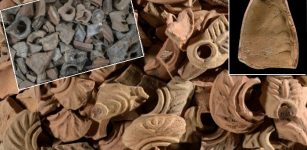 1,500-Year-Old Fingerprints Will Say Much About Potters And Communities That Once Lived In Motza
Archaeology | Nov 10, 2022
1,500-Year-Old Fingerprints Will Say Much About Potters And Communities That Once Lived In Motza
Archaeology | Nov 10, 2022 -
 Giant Ancient Roman Underground Structure Discovered Near Naples, Italy – Aqua Augusta Investigated
Archaeology | Feb 6, 2023
Giant Ancient Roman Underground Structure Discovered Near Naples, Italy – Aqua Augusta Investigated
Archaeology | Feb 6, 2023 -
 Socrates: Great Philosopher And Brave Man Who Still Inspires Many People
Featured Stories | Jul 21, 2016
Socrates: Great Philosopher And Brave Man Who Still Inspires Many People
Featured Stories | Jul 21, 2016 -
 Babylon Excavation Uncovers 478 Artifacts, Including Cuneiform Tablets and Seals
Archaeology | Oct 17, 2024
Babylon Excavation Uncovers 478 Artifacts, Including Cuneiform Tablets and Seals
Archaeology | Oct 17, 2024


